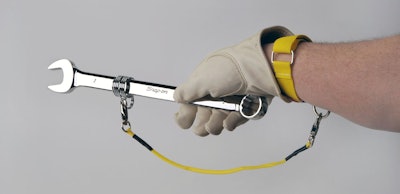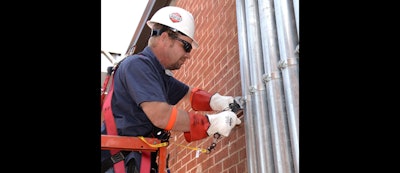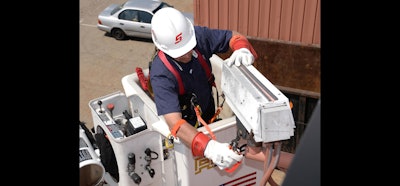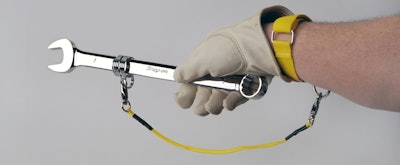
It may be just another day on the job, same as any other. You’re comfortable working hundreds of feet in the air and feel confident with a safety harness securely attached. Most of your tools are tethered, but there are a few exceptions. You’ve been doing this a long time and trust in your safety routine.
This is exactly the type of thought process that can set the stage for a hazardous and potentially fatal workplace accident to occur. Even when workers are being extra careful, working at height is dangerous to coworkers and pedestrians on the ground. Just one mistake can mean the difference between life and death — and not necessarily to those elevated.
There are a number of critical safety precautions that must be taken to make working on elevated platforms as safe as possible, but one of the most important safety measures — tethered tools — is regularly neglected. The consequences of dropping an untethered tool are both frightening and often fatal.
Deadly consequences
In November 2014, a 58-year-old man was killed after being struck in the head with a tape measure that had become dislodged from the belt of a worker on the 50th floor of a high rise construction project in New Jersey. The man wasn’t even directly underneath the falling tool. Rather, the 1-pound tape measure fell nearly 500 feet, ricocheted off a piece of equipment about 15 feet from the ground, bounced once and struck the man’s head. He was just exiting his vehicle to make a delivery to the work site. The man, who wasn’t wearing a hard hat, was transported to the hospital, where he died later that day. A 1-pound tool falling from that height struck the ground traveling about 140 mph.
Unfortunately, accidents like this aren’t isolated incidents. According to OSHA, more than 4,600 workers were killed on the job in 2014 — on average, almost 90 a week or about 13 deaths every day. Furthermore, construction workers account for 20 percent of work related deaths; 874 construction workers were killed on the job site — and 73 of them were killed by falling objects. Dropped objects have become such an epidemic that some companies have implemented policies terminating employees responsible for a drop. Additionally, the U.S. Bureau of Labor Statistics report that being struck by a falling object is the third leading cause of workplace fatalities; many of these accidents are completely preventable.

In any application where work is being performed four feet or more from the ground, or above machinery, implementation of a system to prevent tools from falling is strongly recommended. There are a few basic guidelines from OSHA that industrial sites should follow to help protect workers from falling objects, such as: workers wearing hard hats; platforms with toe boards to prevent things from getting kicked to the ground; and debris nets to catch falling objects. But these recommendations leave gaps in safety. A hard hat serves as little protection from a tool falling several hundred feet. Toe boards can prevent items from being kicked off a platform, but what about a tape measure that slips from a technician’s pocket? And since debris nets are typically porous, small or slender items, such as tools, may not be caught. The best defense is to prevent tools from falling in the first place.
Over the past several decades, OSHA has done a good job is lowering the number of fall deaths because it dictates that workers must wear safety harness while working at height. Worker deaths in America are down — on average, from about 38 worker deaths a day in 1970 to 13 a day in 2014. Deaths from falling objects could also be further lowered if technicians tethered their tools. When technicians don their safety harness, they need to be considering how their tools are tethered. These actions should go hand-in-hand and become second nature on job sites. When that happens, the death rate from falling objects will start to decline.
The New Jersey accident was likely preventable if a drop prevention system had been in place to keep the tape measure from falling.
Old Problems…New Ideas
Tethered tools are not a new concept. Tethering devices come in many shapes and sizes, but many fall short for one reason or another. Some mount in a way that limits the full use of the tool, are difficult to handle, and technicians view them as obstructions to productivity. Others work with only a portion of the tools, leaving some unsecured. With that said, the most common complaint of tethered devices is that they inhibit the functionality of the tool. A tool can be tethered, but if a technician refuses to use the device because it’s too cumbersome, then the design fails and the objective of a safer working environment is not reached.

Engineered Attachment Points
New technologies for drop prevention are emerging that focus on maintaining or enhancing a tool’s functionality. An important development is that these new tethering systems are designed in conjunction with the tool, and not looked at as an afterthought. Developing system components independently is what ultimately compromises functionality and inhibits program implementation. Engineered attachment points must consider the tool’s design and function in order to maintain or improve use when tethered. And, rigorous drop testing to certify the design of attachment points should be in place to ensure safety. Fortunately there are innovative new offerings that do just that. Here are a few examples:
- Locking Pins — Square drive tools and accessories are designed and manufactured with spring loaded lock buttons in square drives. The lock button engages with side lock holes drilled in sockets, extensions, and adaptors ensuring positive retention. A pin release tool is used to separate components in the system. This method is preferred over using quick release tools because a quick release button or collar can be activated inadvertently causing the drive tools to separate and become dangerous dropped objects.
- Rotating Tabs — Screwdrivers are fitted with stainless steel tabs that rotate freely 360° so lanyards do not get tangled around the users hand or the screwdriver handle. This method also leaves all of the handle surfaces available to be used for power and control.
- Safety Coils — The stainless steel coils are installed on wrenches and slide along the wrench handle out of the way from an operator’s hand. This provides full use of the wrench’s handle, which provides reach and leverage when needed.
- Strategic Location — Removable jaws on pipe wrenches are pinned or drilled so the jaw cannot be separated from the wrench handle. This is critical because simply attaching to the hang hole already forged into the wrench handle leaves too great a risk of dropping the removable jaw.

Transporting and Using Tools Safely
In examining ways to make drop prevention systems better for technicians, industry has studied the most common cause of tool drops — the transfer between storage and use. More than half of drop incidents occur during this frequent action. With most systems, in order to secure a tool, the technician must first retrieve it and then clip or attach it to a lanyard. This process involves both hands and creates potential for dropped tools. This practice is one that required attention. When working at height, technicians should maintain three points of contact for their safety: two feet on a platform and one hand on a secured infrastructure. By using both hands to handle tools and attach the tool to a tethering device, the technician loses one point of contact.
To address this concern, tethering systems have been developed that eliminate the additional actions normally required to secure tools. An example is a tool belt in which each tool has its own pouch or holster with a tethering device already installed. This enables the technician to simply remove the tool, use it, and put it back into its place on the belt — all with one hand. Since every tool is already independently tethered, no device needs to be attached, which removes transferring issues and eliminates drops.
Belts and harnesses can be custom designed to meet specific applications within different industries. Whether power generation, oil and gas, or utilities, systems can be designed with the proper tools, and ordered as turn-key solutions with a single part number. Every tool is already installed with its own tethered device and ready to be used: just open the box, put on the belt, and go to work.
Tethering devices as PPE
As the New Jersey accident illustrates, the reason for tethering tools is to prevent them from falling. Anything that’s on an elevated work platform can become a fall hazard, and that includes tools. There’s a reason why a technician puts on a fall-arrest safety harness, because he’s heading to work at height and doesn’t want to fall. When working in this environment, technicians need to ensure their tools are tethered. This is the mindset change that needs to occur on job sites. Safety is the No. 1 objective on any work site, and eliminating dropped objects has become as important as eliminating falls when working toward achieving a safe work environment.
John Martell is a Product Manager for Snap-on Industrial’s Tools at Height tethered tool program. He can be reached at 262-656-5337, or email: [email protected].






















